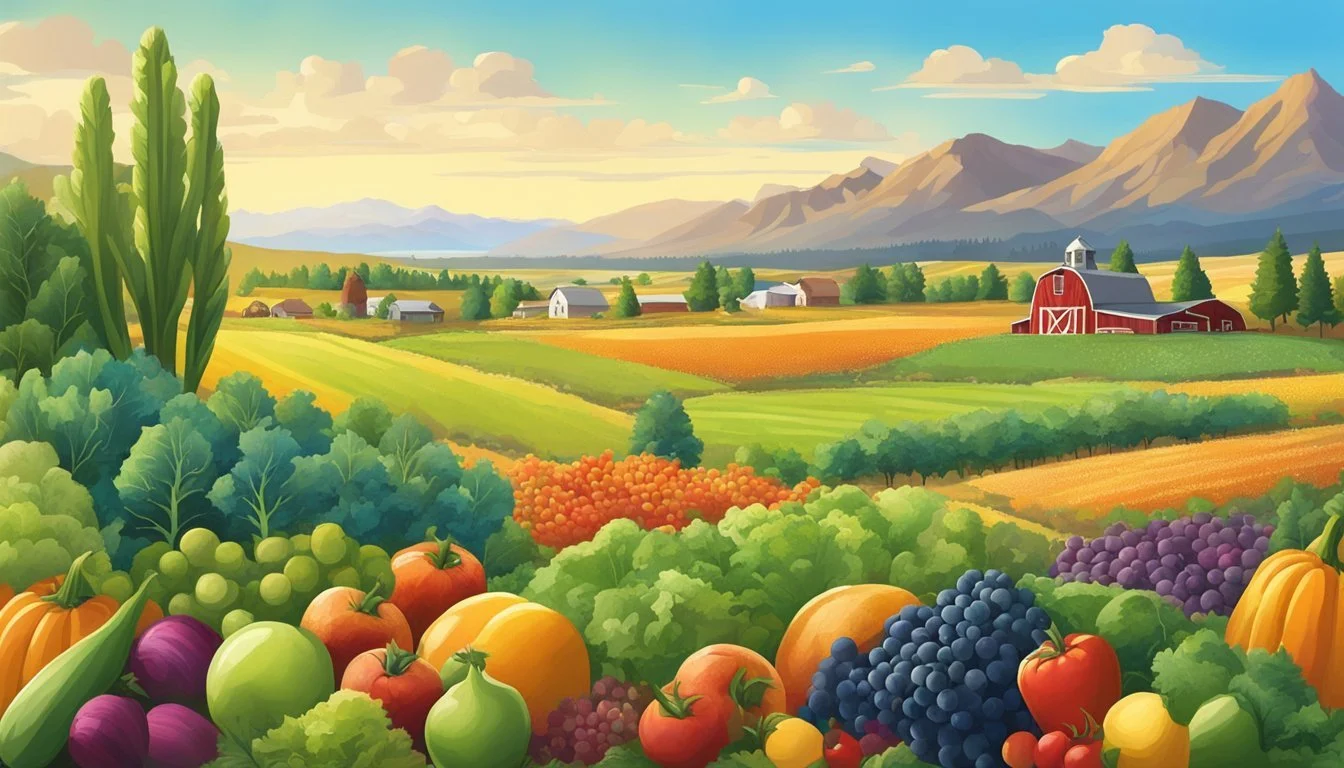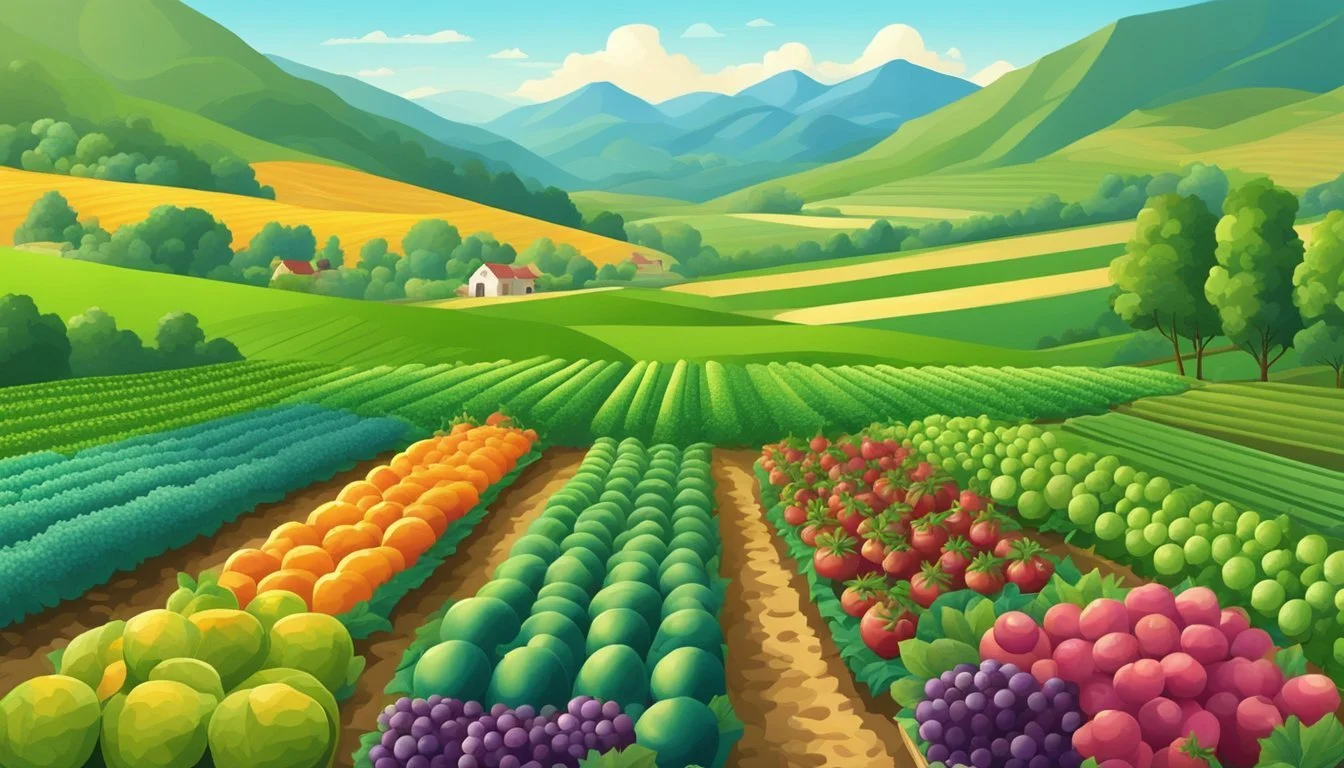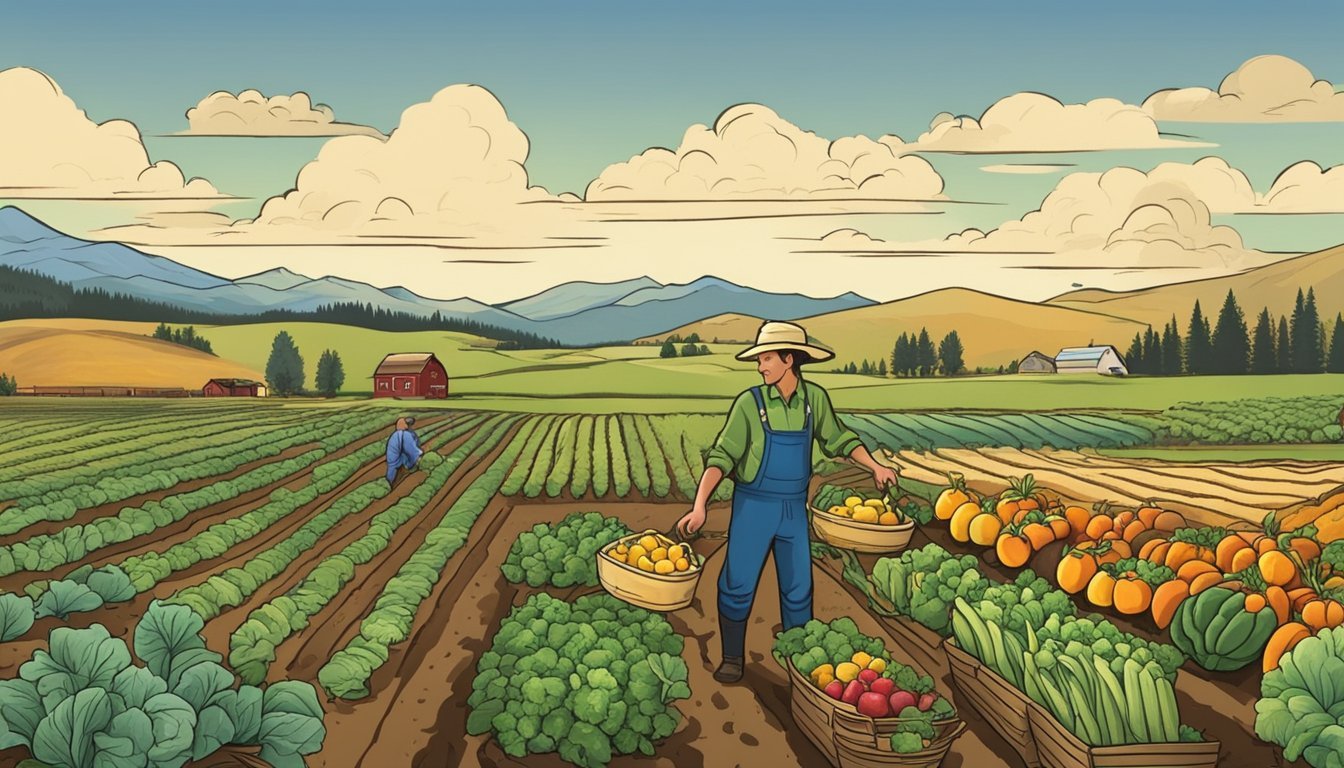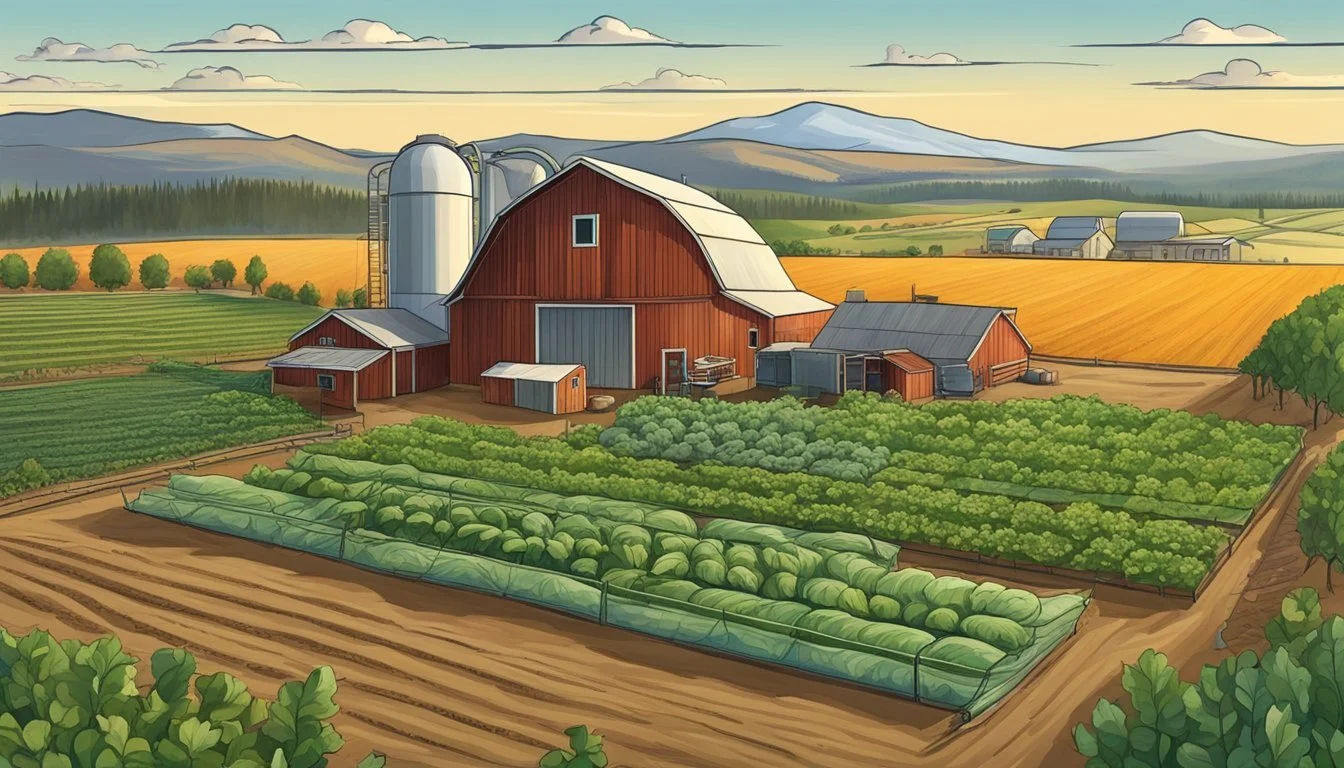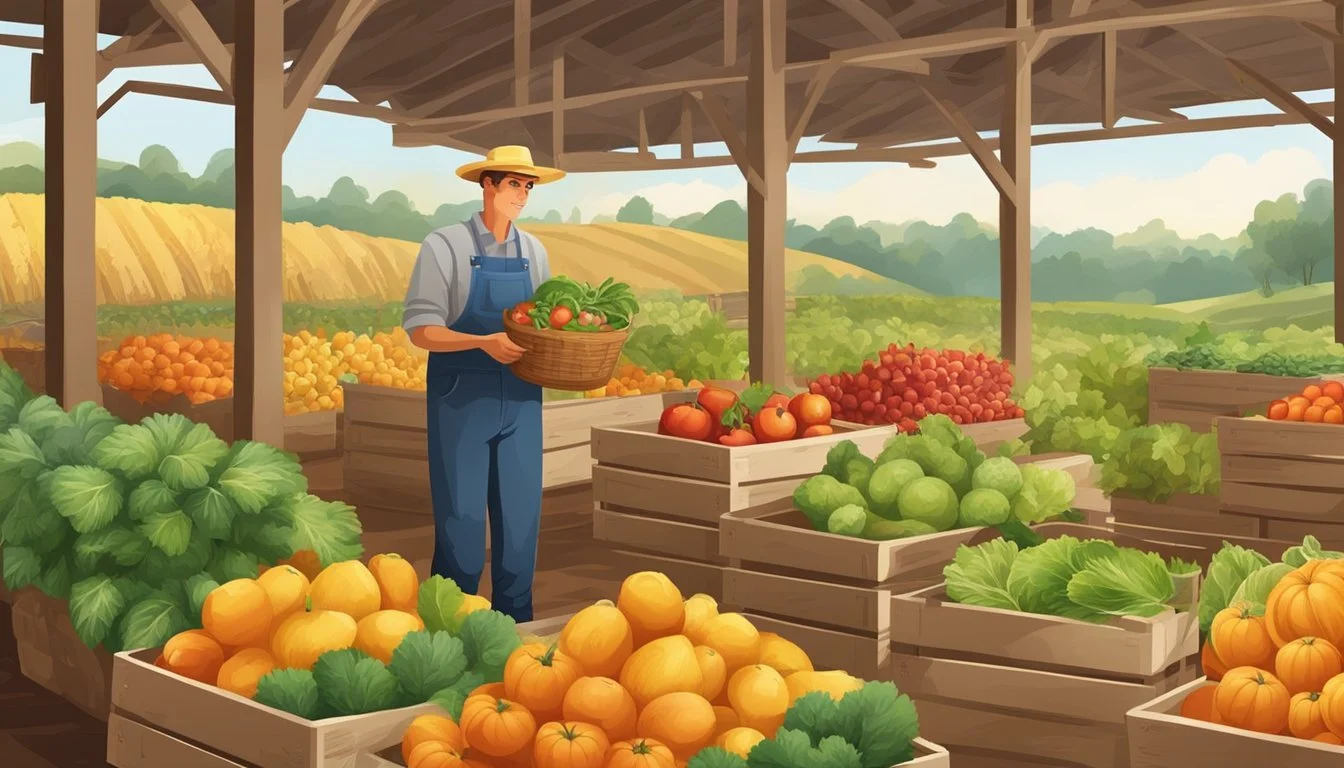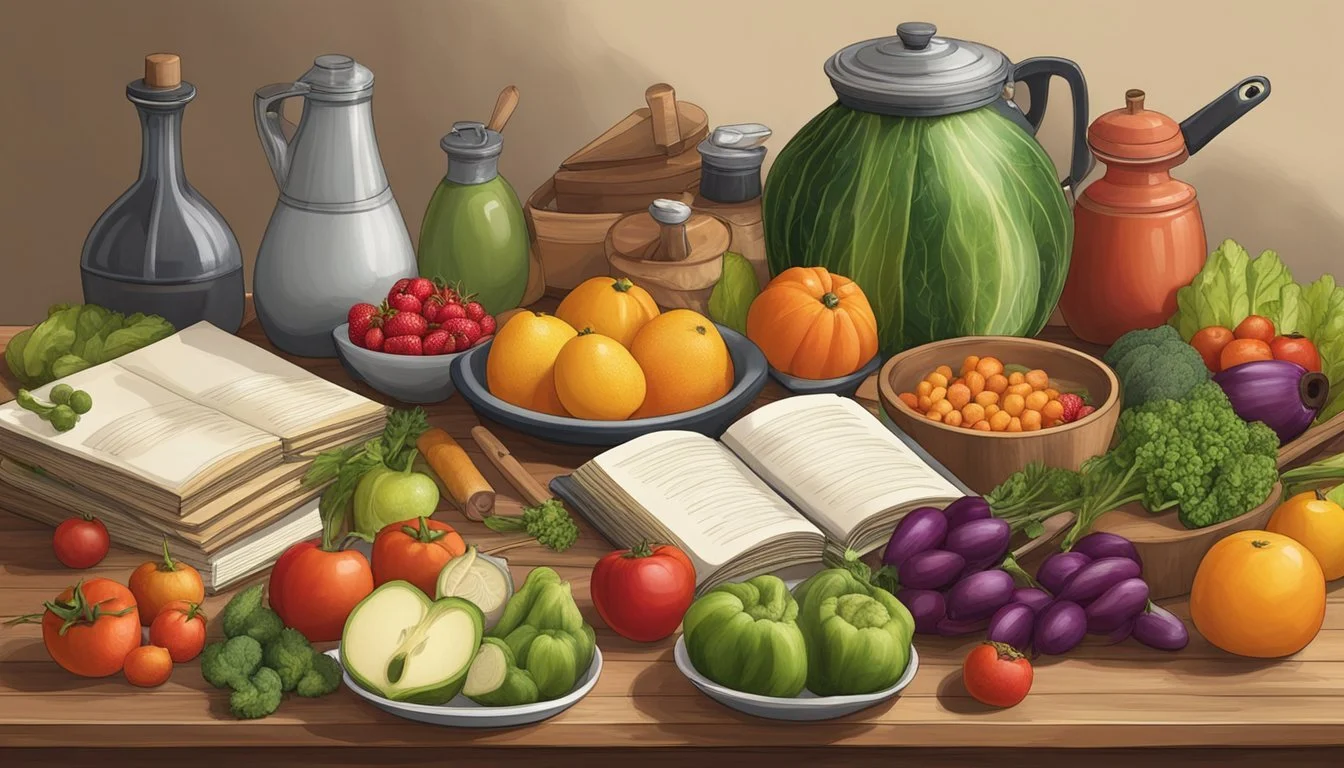Montana Seasonal Fruit & Veg Guide
Your Year-Round Companion
Montana's diverse climate and fertile soil allow for a rich variety of produce to flourish throughout the state's distinct seasons. With a focus on regional and seasonal eating, Montanans have cultivated a farm-to-table ethos that elevates the consumption of locally grown fruits (What wine goes well with fruit?) and vegetables. The state's agriculture is defined by a later harvest and a shorter growing season compared to many other regions, leading to a reliance on cool-weather crops and the need for storage to extend the availability of the harvest.
Montana's seasonal produce chart is a testament to the state's agricultural rhythm, indicating when fresh items like fruits and vegetables are typically available. This chart is pivotal for residents and chefs alike to plan menus and for consumers aiming to eat seasonally and locally. The range of fruits and vegetables each season offers reflects both the state's unique growing conditions and the adaptability of its farmers.
By understanding the seasonal availability of the state's produce, Montanans support local farmers, reduce environmental impact, and enjoy the freshest possible ingredients. Winter might limit the availability of fresh-grown items, but with canning, freezing, and dehydrating, many of Montana's harvest can be savored year-round. This guide, deeply ingrained in local tradition, is a valuable resource for anyone looking to embrace Montana's seasonal variety and contribute to the farm-to-table movement.
What’s in Season in Montana Right Now?
Understanding Montana's Grow Seasons
Montana's diverse climate across its regions marks distinctive growing seasons, each with its own set of fruits and vegetables. The state experiences a shorter growing period compared to much of the country, so seasonality is particularly important for the local farm-to-table movement.
Spring Fruits and Vegetables
In the spring, as the frost begins to thaw, Montana's farms start to yield early vegetables. One can find a range of greens such as spinach, lettuce, and kale. Hardy herbs like chives (how long do chives last?) and parsley also make their appearance. This is the season when garden preparations begin, and the first fresh flavors emerge after the long winter.
Spinach
Lettuce
Kale
Chives
Parsley
Summer Bounty
With summer's full swing, Montana luxuriates in abundant sunshine and warmth, enabling a wider variety of produce. It's the ideal time for tomatoes, peppers, and cucumbers (how long do cucumbers last?) to thrive. Fruits like cherries (how long do cherries last?) and berries become available, and summer squash grows prolifically. Roots like carrots and beets (how long do beets last?) are also harvested during this period.
Tomatoes
Peppers
Cucumbers
Cherries
Berries
Summer Squash
Carrots
Beets
Autumn Harvest
As fall sets in, Montana's harvests become heartier. Apples and pears are picked from orchards, while pumpkins and winter squash signal the approaching Halloween and Thanksgiving festivities. Farmers also harvest staples like potatoes and onions, essential for winter storage.
Apples
Pears
Pumpkins
Winter Squash
Potatoes
Onions
Winter Offerings
Winter in Montana is a time for stored and preserved foods due to the harsh weather conditions that limit fresh produce. However, some root vegetables like turnips and beets can still be cellared and used throughout the colder months. Greenhouses also provide fresh greens such as microgreens and lettuce to those seeking fresh produce in winter.
Turnips
Beets
Microgreens
Lettuce
Choosing the Right Varieties
In Montana, success in growing seasonal produce is greatly influenced by selecting appropriate varieties that can thrive in its unique climate conditions. Gardeners and farmers must carefully consider each cultivar's adaptability to summer warmth and winter cold.
Selecting Summer Varieties
For summer crops, Montanans benefit from choosing varieties that can make the most of the state's relatively short growing season.
Summer Squash: Varieties such as 'Yellow Crookneck' or 'Zucchini Elite' grow quickly and are able to produce a harvest before the first frost.
Apples: While not exclusive to summer, early-ripening apple varieties like 'Yellow Transparent' and 'Lodi' begin maturing by late summer.
Pears: Summer-fruiting pear varieties such as 'Starkrimson' and 'Bartlett' are suitable for Montana's climate and can yield fruit before the colder weather sets in.
Opting for Winter Hardy Selections
When planning for winter, one must opt for selections that can withstand freezing temperatures and still provide a bountiful yield.
Winter Squash: Varieties such as 'Acorn', 'Buttercup', and 'Delicata' are known for their hardiness and ability to be stored for winter consumption.
Apples: Winter-hardy apple varieties like 'Haralson' and 'McIntosh' can endure Montana's cold conditions and still provide late-season fruit.
Planting and Crop Availability
Montana's planting seasons and crop availability are significantly influenced by its varied climate. Successful harvests depend on understanding the ideal planting times and expected harvest periods for each season.
Spring Planting Guide
In Montana, spring planting typically starts as the threat of frost recedes. Gardeners and farmers should consult local frost dates to time their planting for optimal growth. Key crops to plant during this time include:
Cool-weather vegetables: Lettuce, spinach, and peas can be sown as early as March or April.
Root crops: Plant carrots and beets in early spring for a summer harvest.
Harvest times for spring-planted crops will vary, but many leafy greens can be picked as soon as they reach a suitable size.
Summer Planting and Growth
The summer months in Montana offer longer daylight hours and warmer temperatures, which are ideal for:
Fruit and vegetables: Tomatoes, peppers, and cucumbers should be planted once the soil has warmed adequately.
Continual planting: Successive planting of crops like beans and salad greens can yield multiple harvests.
Harvest times for summer-planted crops generally range from late summer into early fall.
Fall Planning and Planting
Fall in Montana necessitates planning for both harvest and new plantings:
Harvest: Summer-planted crops should be harvested before the first frost.
Fall planting: Garlic and some varieties of onions can be planted in late fall for a summer harvest next year.
Monitoring weather data is crucial for fall planting decisions, as early frost can impact crop viability.
Winter Preparation and Planning
Winter is a time for preparation and planning rather than active planting:
Infrastructure: Repair and prepare greenhouses or cold frames for winter and early spring planting.
Soil care: Adding mulch and organic matter can help protect soil quality through harsh Montana winters.
Understanding the seasonal limitations and preparing for the next planting cycle ensures year-round productivity in Montana's unique agricultural landscape.
Soil and Water Management
The productivity of Montana's agricultural landscape significantly depends on the effective management of soil and water resources. These elements are intertwined, affecting everything from crop yield to environmental sustainability.
Soil Preparation and Maintenance
Soil Composition: Montana's diverse soil types require tailored preparation strategies. The state's soil scientists emphasize the importance of understanding soil-water interactions to manage salinity and sodicity—conditions that could hinder growth.
pH Balance: Checking soil pH is instrumental in maintaining healthy soil. Montana State University suggests that proper pH levels promote beneficial microbial activity and nutrient availability.
Fertilizer Use: Applying the right type and amount of fertilizer is crucial. Over-fertilization can lead to chemical runoff, which may negatively impact water quality.
Irrigation and Water Conservation
Water Management: Strategic irrigation is vital given Montana's average annual precipitation of 14 inches. Effective water management practices include:
Irrigation Efficiency: Farmers and ranchers work with agencies like NRCS to implement systems that improve water and electrical efficiencies.
Conservation Techniques: These may involve drip irrigation and scheduled watering to reduce water use without compromising plant growth.
Sunlight and Shade: Considering Montana's varying sunlight needs for different crops, one must plan the irrigation accordingly. Plants like tomatoes demand substantial daily sunlight, but others such as lettuce can thrive with some shade—which influences water requirements.
Pest and Disease Control
Effective management of pests and diseases is essential to maintaining a healthy farm to table operation in Montana. This section covers strategies to mitigate insect infestations and prevent or address common plant diseases.
Managing Insects and Pests
Codling Moth: A significant pest in Montana, particularly for apples, pears, and walnuts (how long do walnuts last?). Farmers should monitor these moths closely and time control methods to target specific life stages of the pest. - Common control methods include:
Pheromone Traps: To monitor moth activity.
Cultural Controls: Sanitation and fruit thinning to reduce moth populations.
Biological Controls: Introduction of natural predators or parasitoids.
Aphids: Known to affect a wide range of crops. They can be managed through:
Monitoring: Regularly check plants for aphid presence.
Natural Predators: Encourage beneficial insects like ladybugs.
Foliage Sprays: Neem oil or insecticidal soaps as a last resort.
Disease Prevention and Treatment
Powdery Mildew: A prevalent affliction in Montana that impacts leaves, shoots, and fruit. Prevention techniques include:
Resistant Varieties: Selecting seeds for plants less susceptible to mildew.
Environmental Control: Ensure good air circulation and avoid overhead watering to reduce humidity.
Fire Blight: Caused by the bacterium Erwinia amylovara, poses a significant threat to apple and pear trees in Montana. Strategies to combat fire blight consist of:
Sanitation: Prune and dispose of infected plant material promptly.
Chemical Controls: Application of appropriate bactericides during vulnerable stages of plant development.
Harvesting and Storage Techniques
Optimal harvesting and storage of fruits and vegetables are crucial for maintaining freshness and flavor. Employing the right techniques ensures the longevity of produce and its best possible taste.
Fruit Picking Strategies
Cherries and apples in Montana should be harvested when fully colored and firm to touch. They are ideally picked in the cool early morning hours and should be handled gently to avoid bruising. Once picked, they must be cooled immediately to extend shelf life.
Cherries: Pull the cherries with stems intact; avoid tearing off the fruit 'cap.'
Apples: Twist the fruit upwards and give a gentle pull; avoid shaking branches.
Vegetable Harvesting Methods
Vegetables like carrots and beets require a different approach. Test for readiness by size, harvesting carrots when they are at least ½ inch in diameter and beets at around 1-3 inches.
Leafy Greens: Harvest in the morning when leaves are plump with water.
Root Vegetables: Loosen soil around the base before pulling to prevent damage.
Storage and Preservation
Produce longevity depends on proper storage. Low temperatures and controlled humidity are essential for most items, but specific vegetables like potatoes and onions require a cool, dry, and dark environment for storage.
Apples: Best stored in a cold, slightly humid place, away from strong-smelling foods.
Vegetable Storage Condition Expected Shelf Life Potatoes Cool, dark, and well-ventilated 2-3 months Onions Cool, dry, and dark Up to 1 month Carrots Refrigerated in a plastic bag 3-4 weeks Beets Refrigerated with tops removed 2-3 weeks
For longer preservation, techniques such as canning, freezing, and drying can be applied, matching the method to the specific type of fruit or vegetable.
Local Markets and Distribution
Access to fresh, seasonal produce in Montana hinges on a network of local markets and distribution channels. These ensure that fruits and vegetables grown in the state reach consumers efficiently.
Farmers' Markets
Farmers' markets across Montana serve as a primary outlet for fresh, locally grown fruits and vegetables. Consumers have direct access to producers, with markets found in various cities and regions. For instance, Helena, the state capital, and other larger cities like Bozeman and Missoula host vibrant farmers' markets where a variety of seasonal produce such as apples, cherries, and root vegetables are available.
Community Supported Agriculture (CSA)
CSAs are popular in Montana, providing a direct-to-consumer model where individuals and families receive a share of the harvest throughout the growing season. This avenue promotes a steady income for farmers and fosters a connection between the consumer and the origin of their food. CSA members may pick up their share in a designated location within the city or have it delivered to their home, depending on the farm's offerings.
Retail and Wholesale Opportunities
The state's produce also finds its way to consumers through retail and wholesale avenues. Grocery stores, both independent and chain outlets, source seasonal items from Montana's agricultural landscape. Wholesale distributors work with farms to supply restaurants and institutions with fresh fruits and vegetables, helping to maintain a consistent presence of local produce in the wider market. These channels play a crucial role in keeping the farm-to-table movement strong, especially within the state's various regions, from the more rural areas to the bustling city markets.
Seasonal Recipes and Preparation
Montana's distinct seasons offer a diverse range of produce, providing ample opportunities to create dishes that embody the essence of each period. The recipes and preparation techniques discussed highlight the state's regional fruits and vegetables at their peak.
Spring Salads and Sides
In spring, asparagus, radishes, and leafy greens take center stage. A simple vinaigrette pairs perfectly with a salad of fresh, tender greens. Peas add a sweet pop to side dishes, while baby carrots, roasted with herbs, give a colorful and flavorful boost to any meal.
Roasted Radishes with Fresh Herbs
Pea Tendril and Baby Green Salad with Light Lemon Dressing
Honey-Glazed Baby Carrots with Thyme
Summer Grills and Picnics
Summer signals the arrival of cherries, berries, and succulent stone fruits like peaches. Grilled vegetable kebabs (What wine goes well with grilled vegetable kebabs?) with zucchini and bell peppers are perfect for picnics. Incorporate Montana-grown tomatoes and cucumbers in fresh salsas (how long do fresh salsas last?) or as refreshing additions to salads.
Grilled Peach and Cherry Salsa
Zucchini and Bell Pepper Kebabs with Herb Marinade
Cucumber Tomato Salad with Red Wine Vinaigrette
Hearty Fall Dishes
As temperatures cool, root vegetables like beets and potatoes provide comfort in hearty dishes. A roasted beet salad with nuts and cheese is both earthy and satisfying. Stews featuring a variety of squashes and potatoes make for warming, filling meals that highlight the fall harvest.
Beet and Goat Cheese Salad with Walnuts
Butternut Squash Stew with Heirloom Potatoes
Winter Warmers
During Montana's chilly winters, storage crops such as apples, onions, and winter squashes are culinary staples. Starchy potatoes and carrots serve as the backbone for rich, warming soups. Baked desserts featuring local apples and honey are a comforting end to any winter feast.
Caramelized Onion and Potato Soup with Fresh Rosemary
Baked Apple Crisp with Local Honey Drizzle
Sustainable Farming Practices
Sustainable farming practices in Montana are pivotal for the production of seasonal fruits and vegetables. Farmers concentrate on conserving water, enriching soil, and fostering biodiversity to ensure the future of agriculture in the region.
Organic Farming
Montana producers are increasingly adopting organic farming methods which prohibit the use of synthetic pesticides and fertilizers. This approach emphasizes the use of natural substances and crop rotations to maintain healthy soil. Organic farming in Montana not only supports the production of clean and chemical-free produce but also contributes to a sustainable environment by preserving water quality and preventing soil degradation.
Key components of Organic Farming:
Soil management: Maintaining soil fertility through composting and crop diversification.
Pest control: Using natural predators and biocontrol agents instead of synthetic chemicals.
Water conservation: Implementing irrigation practices like drip irrigation to minimize water usage.
Regenerative Agriculture
Another sustainable practice gaining traction is regenerative agriculture. This holistic approach goes beyond organic farming by actively restoring the soil's organic matter, leading to improved water retention, carbon sequestration, and overall soil health. Regenerative practices include no-till farming, cover cropping, and diverse crop rotations which not only enhance the soil but also support a more resilient ecosystem against the impacts of climate change.
Key components of Regenerative Agriculture:
Soil revitalization: Increasing soil biodiversity to boost its structure and nutrient cycling.
Water management: Enhancing soil structure to increase water infiltration and storage.
Crop resilience: Fostering plant diversity to reduce vulnerability to pests and diseases.
In embracing these agricultural practices, Montana farmers ensure that consumers can enjoy a diverse range of fresh, seasonal, and sustainably-grown fruits and vegetables.
Community and Education
Montana's initiatives in seasonal farm-to-table programs play a pivotal role in community engagement and the education of its residents. These efforts strengthen the state's resolve in promoting local agriculture and ensuring food security, while instilling in their citizens a deeper understanding of their food systems.
Local Agriculture Education
In Montana, the local community benefits from various programs designed to enhance the knowledge and appreciation of agriculture. School Gardens serve as a living classroom where students can gain practical experience in growing food. This hands-on approach not only supplements traditional education but also promotes healthy eating habits as children learn to cultivate and harvest fresh produce. Farm Field Trips further extend this learning, allowing students to witness farming operations and fostering a connection between the food on their plates and the land it came from.
Food Security Initiatives
Ensuring that all community members have access to healthy, locally-sourced food is at the heart of Montana's food security initiatives. The state leverages programs such as Farm to School, which incorporates local foods into school cafeterias. By doing so, they not only support local farmers but also provide nutritious meals to students, which can positively impact their academic performance and long-term health. Education about food origins and seasonal availability is integral to these initiatives, as it empowers residents to make informed choices about their food, thereby bolstering the community's overall food security.
Future of Farm to Table in Montana
Montana's farm to table future looks promising with ongoing innovations in agriculture and supportive policy frameworks bolstering the state’s economy.
Innovation in Agriculture
Montana State University is at the forefront of agricultural research, which is fostering advancements in the state’s fruit industry through The Montana Heritage Orchard Program. This initiative is exploring the viability of new fruit varieties that can withstand local climatic conditions, potentially leading to a more diverse and resilient agricultural sector.
Policy and Economic Factors
Economic support for farm to table initiatives is growing. House Bill 276, though tabled, represents a potential policy push to connect local producers with food banks, infusing $1 million over two years into the state’s economy. This not only supports local farmers but could also establish a precedent for future funding, strengthening the link between producers and consumers. The bill has gained popularity for its vision of a symbiotic relationship between agricultural prosperity and tackling food insecurity.

